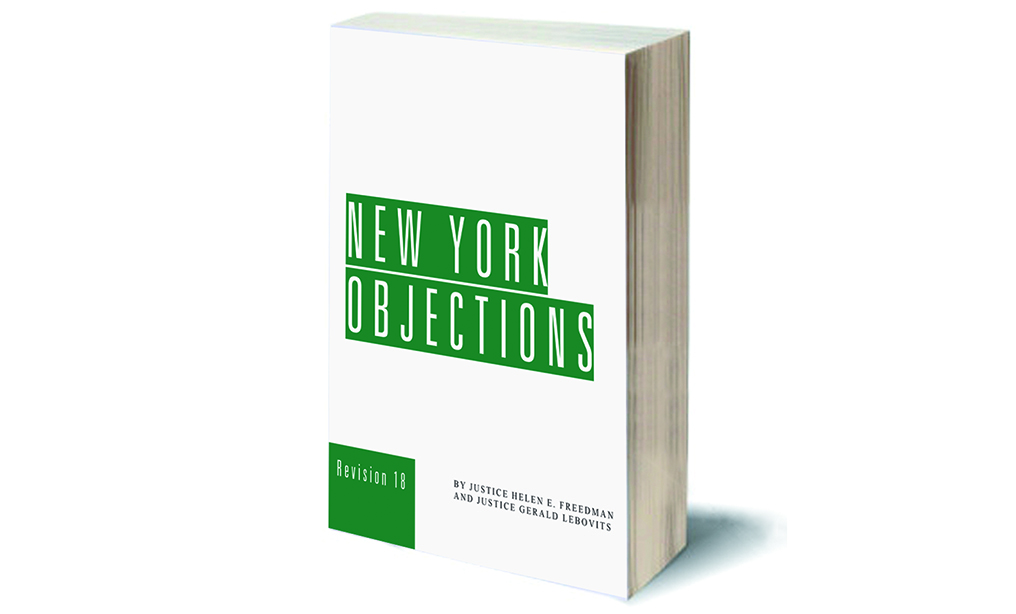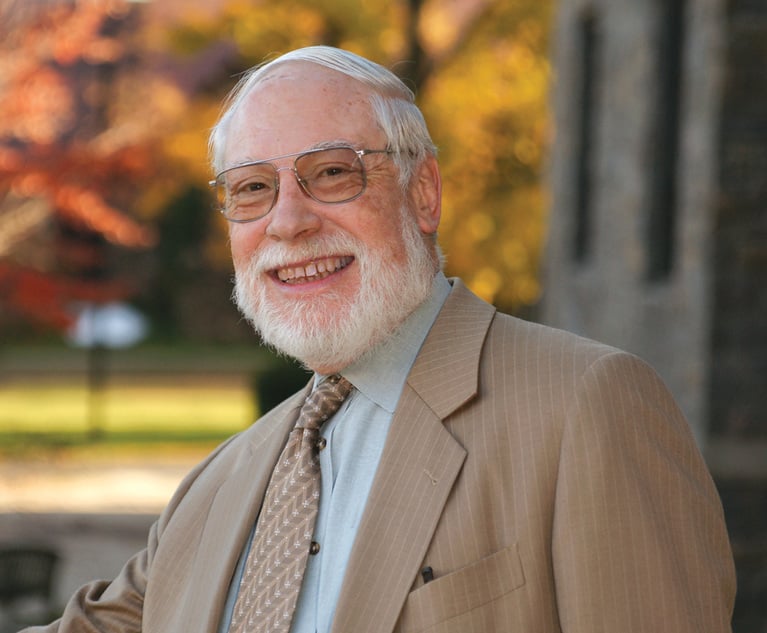Objections: Making Them and Opposing Them
It does a particularly good job of discussing the landmark Crawford case, the U.S. Supreme Court decision that has had such a dramatic impact on the use of hearsay evidence in criminal cases.
August 13, 2018 at 03:13 PM
6 minute read

Reviewed by David Epstein
New York Objections By Helen E. Freedman and Gerald Lebovits, 534 pages, James Publishing, $239.00
Your adversary attempts to introduce inadmissible evidence. You begin to rise from your chair, hoping that you will able to articulate the grounds for your objection. Of course, preparation is the key to knowing the grounds for your objection and persuading the judge to sustain it.
How do you present your case properly and effectively, based on admissible evidence? When should you object to your adversary's actions and evidence, and what arguments should you make to support your objection? How should you respond to your adversary's objections? Of course, there are numerous treatises, books and articles on evidence and trial tactics, which include coverage of making and responding to objections. However, few publications combine these subjects in as clear and useful a way as New York Objections.
New York Objections has been guiding lawyers since it was published almost twenty years ago. Unfortunately, its original author, Justice Helen E. Freedman, stopped updating the volume in 2015. Justice Gerald Lebovits has come to the rescue, turning his encyclopedic knowledge of evidence and trial practice, and superb writing skills, to a complete update of this work.
Justice Lebovits is not only a fine jurist but also a highly respected writer on numerous topics, including legal writing and evidence. A judge for almost twenty years, he is an acting New York Supreme Court justice. Countless students have had the benefit of his knowledge and teaching expertise from his years teaching at Columbia, Fordham, St. John's and New York Law School. Justice Lebovits is the author of six books and too many articles to count. He has done an excellent job of revising the volume and bringing it up-to-date. New York Objections is well organized and easy to use. It is not limited to coverage of evidentiary issues but rather deals with the use of objections in all aspects of the trial, from opening statements through submitting the case to the jury. Each topic includes a detailed discussion of the law.
Each chapter in New York Objections sets out the specific objections to be made. The legal discussion that follows is thorough, yet succinct and to the point. Justice Lebovits knows what the trial advocate must know, and stays clear of unnecessary esoteric fluff. A thorough compilation of brief case summaries is included in every chapter, summaries that can be used as a quick reference guide to the precedent on point. The cases are carefully selected, well organized and succinctly and accurately discussed.
Perhaps most interesting are the sections providing practical advice. These include practice tips, how to lay a foundation for the particular form of evidence and objection tactics. The sections on tactics deal not only with the tactics in making objections but also with the tactics in replying to objections. This practical advice takes the novice by the hand and leads him or her through the process. At the same time, it provides insights that will be useful to the more experienced practitioner.
The first chapter of the volume deals with objections in general. This includes guidance on the important but often overlooked need to preserve the record for appeal. At the same time, it emphasizes the importance of convincing the trial judge that your position is correct, rather than hoping for relief on appeal. The discussion moves on to give practical advice on actually making the objection. In front of the jury? At a sidebar? By making a motion in limine? Motions in limine are also covered in detail, as are offers of proof.
The next chapter covers jury selection, including the law, examining and challenging members of the panel, and, of course, objections.
The book then moves on to the opening statement, followed later in the book by summation. The volume provides among the best coverage I have seen of these important tools of persuasion, including the practical advice that counsel should not object during his or her adversary's summation unless there is a clear breach of propriety.
The volume then turns to its extensive coverage of evidence, starting with the often difficult topic of hearsay. It does a particularly good job of discussing the landmark Crawford case, the U.S. Supreme Court decision that has had such a dramatic impact on the use of hearsay evidence in criminal cases. A good example of the book's approach is its coverage of the hearsay exception for past recollection recorded. It starts by spelling out the specific objection to be made. This is followed by step-by-step guidance on laying a foundation, the tactics involved in making an objection and guidance on how to respond to the objection. The chapter concludes with a quick reference guide to the cases on point.
The book's coverage of privileges is excellent. It includes constitutional, statutory and common law privileges. A large number of case summaries are provided, well-organized and easy to use. There are practical tips, such as furnishing the court with copies of statutes to support a claim of medical privilege.
New York Objections' coverage of real evidence and demonstrative evidence, including photographs and documents, recognizes the special problems surrounding the effective use of such evidence. It focuses on laying a foundation and presenting the evidence in a persuasive manner.
The remaining chapters provide similarly excellent coverage of witness competence, direct and cross-examination, expert witnesses, judicial and attorney conduct, submitting the case to the jury, and depositions.
New York Objections is an endlessly useful resource for the New York trial lawyer. Its sound advice, easy to use organization and clarity will make it a tool that the trial lawyer will turn to over and over.
David M. Epstein teaches at New York Law School and is the author, with Dean Glen Weissenberger, of the New York Evidence Trial Manual.
This content has been archived. It is available through our partners, LexisNexis® and Bloomberg Law.
To view this content, please continue to their sites.
Not a Lexis Subscriber?
Subscribe Now
Not a Bloomberg Law Subscriber?
Subscribe Now
NOT FOR REPRINT
© 2025 ALM Global, LLC, All Rights Reserved. Request academic re-use from www.copyright.com. All other uses, submit a request to [email protected]. For more information visit Asset & Logo Licensing.
You Might Like
View All
Law Journal Column on Marital Residence Sales in Pending Divorces Puts 'Misplaced' Reliance on Two Cases
8 minute read

A Time for Action: Attorneys Must Answer MLK's Call to Defend Bar Associations and Stand for DEI Initiatives in 2025
5 minute readTrending Stories
- 1With DEI Top of Mind, Black Judges Discuss Growing Up During Segregation, Efforts to Diversify the Profession
- 2Big Law's Middle East Bet: Will It Pay Off?
- 3'Translate Across Disciplines': Paul Hastings’ New Tech Transactions Leader
- 4Milbank’s Revenue and Profits Surge Following Demand Increases Across the Board
- 5Fourth Quarter Growth in Demand and Worked Rates Coincided with Countercyclical Dip, New Report Indicates
Who Got The Work
J. Brugh Lower of Gibbons has entered an appearance for industrial equipment supplier Devco Corporation in a pending trademark infringement lawsuit. The suit, accusing the defendant of selling knock-off Graco products, was filed Dec. 18 in New Jersey District Court by Rivkin Radler on behalf of Graco Inc. and Graco Minnesota. The case, assigned to U.S. District Judge Zahid N. Quraishi, is 3:24-cv-11294, Graco Inc. et al v. Devco Corporation.
Who Got The Work
Rebecca Maller-Stein and Kent A. Yalowitz of Arnold & Porter Kaye Scholer have entered their appearances for Hanaco Venture Capital and its executives, Lior Prosor and David Frankel, in a pending securities lawsuit. The action, filed on Dec. 24 in New York Southern District Court by Zell, Aron & Co. on behalf of Goldeneye Advisors, accuses the defendants of negligently and fraudulently managing the plaintiff's $1 million investment. The case, assigned to U.S. District Judge Vernon S. Broderick, is 1:24-cv-09918, Goldeneye Advisors, LLC v. Hanaco Venture Capital, Ltd. et al.
Who Got The Work
Attorneys from A&O Shearman has stepped in as defense counsel for Toronto-Dominion Bank and other defendants in a pending securities class action. The suit, filed Dec. 11 in New York Southern District Court by Bleichmar Fonti & Auld, accuses the defendants of concealing the bank's 'pervasive' deficiencies in regards to its compliance with the Bank Secrecy Act and the quality of its anti-money laundering controls. The case, assigned to U.S. District Judge Arun Subramanian, is 1:24-cv-09445, Gonzalez v. The Toronto-Dominion Bank et al.
Who Got The Work
Crown Castle International, a Pennsylvania company providing shared communications infrastructure, has turned to Luke D. Wolf of Gordon Rees Scully Mansukhani to fend off a pending breach-of-contract lawsuit. The court action, filed Nov. 25 in Michigan Eastern District Court by Hooper Hathaway PC on behalf of The Town Residences LLC, accuses Crown Castle of failing to transfer approximately $30,000 in utility payments from T-Mobile in breach of a roof-top lease and assignment agreement. The case, assigned to U.S. District Judge Susan K. Declercq, is 2:24-cv-13131, The Town Residences LLC v. T-Mobile US, Inc. et al.
Who Got The Work
Wilfred P. Coronato and Daniel M. Schwartz of McCarter & English have stepped in as defense counsel to Electrolux Home Products Inc. in a pending product liability lawsuit. The court action, filed Nov. 26 in New York Eastern District Court by Poulos Lopiccolo PC and Nagel Rice LLP on behalf of David Stern, alleges that the defendant's refrigerators’ drawers and shelving repeatedly break and fall apart within months after purchase. The case, assigned to U.S. District Judge Joan M. Azrack, is 2:24-cv-08204, Stern v. Electrolux Home Products, Inc.
Featured Firms
Law Offices of Gary Martin Hays & Associates, P.C.
(470) 294-1674
Law Offices of Mark E. Salomone
(857) 444-6468
Smith & Hassler
(713) 739-1250







